A US$50tn opportunity: Why today's woes drive tomorrow's winners
Without stating the obvious, 2022 has gotten off to a rather rough start. Many were infected with the Omicron variant (including the majority of the Livewire office), while markets stopped climbing their wall of worry to sink into the red.
If that wasn't bad enough, La Niña reared her ugly head, inundating Australia's Eastern coast with far more than a bucketload of rain. Meanwhile, Russia's Vladimir Putin has reared his ugly head to wage a horrendous war on Ukraine, a tyrannous disregard for human rights.
In times like these, it may seem apt to stick your head in the sand or say a few Hail Marys - anything that could possibly drown out the noise, bad news and renew some hope in humanity.
But for Munro Partners' Nick Griffin and James Tsinidis, there is a silver lining; the difficulties we are witnessing (and experiencing today) will accelerate the decarbonisation of the planet, ultimately helping to build a brighter future.
Munro has recently launched a Climate Change Leaders Fund (ASX: MCCL), which invests in 15-20 structural winners that will help to enable the transition towards a greener future. These are not the "best" environmental, social and governance (ESG) companies in the world, but rather those with the products, technologies and services that can assist in the decarbonisation of the planet.
"(This is) the start of the biggest S curve, we think, for the next 30 years. And so it's obviously the biggest opportunity today," Griffin said.
"It is abundantly clear now that the world is not doing enough to stop temperatures rising by more than one and a half degrees*... We know it's going to cost a lot of money to get to net-zero by 2050. But what's becoming more and more apparent is the cost of not getting there is actually going to be far worse."
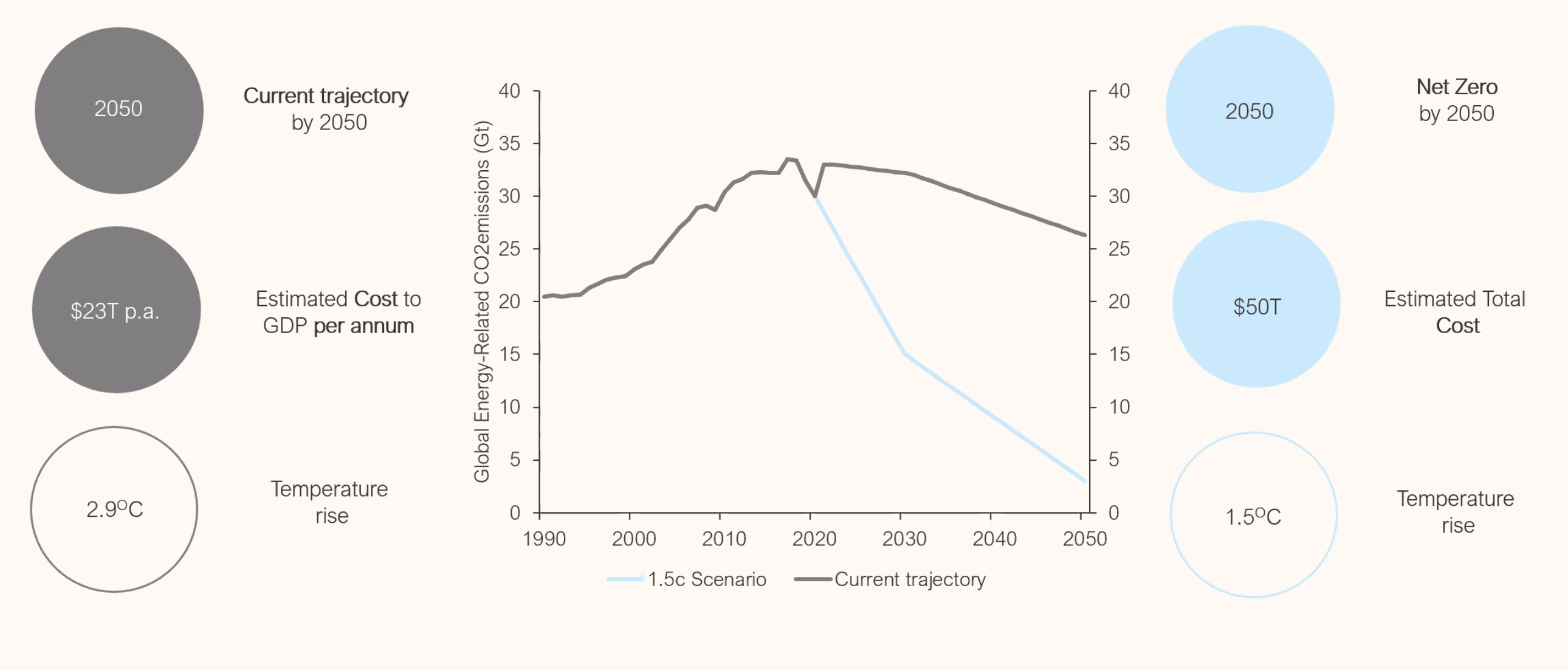
In a webinar on Wednesday, the Munro team said they expect the transition to net-zero by 2050 will cost US$50 trillion dollars. This is more than the GDP of the US, Europe and Australia combined.
"If that's $50 trillion to decarbonize the planet, then that's $50 trillion of revenue to the companies that are going to enable that decarbonisation," Griffin said.
*The Paris Agreement is a legally binding international treaty that aims to limit global warming to below 2 and preferably to 1.5 degrees Celsius by 2050.
Where that US$50 trillion will be spent (and which companies will receive the lion's share of investment)
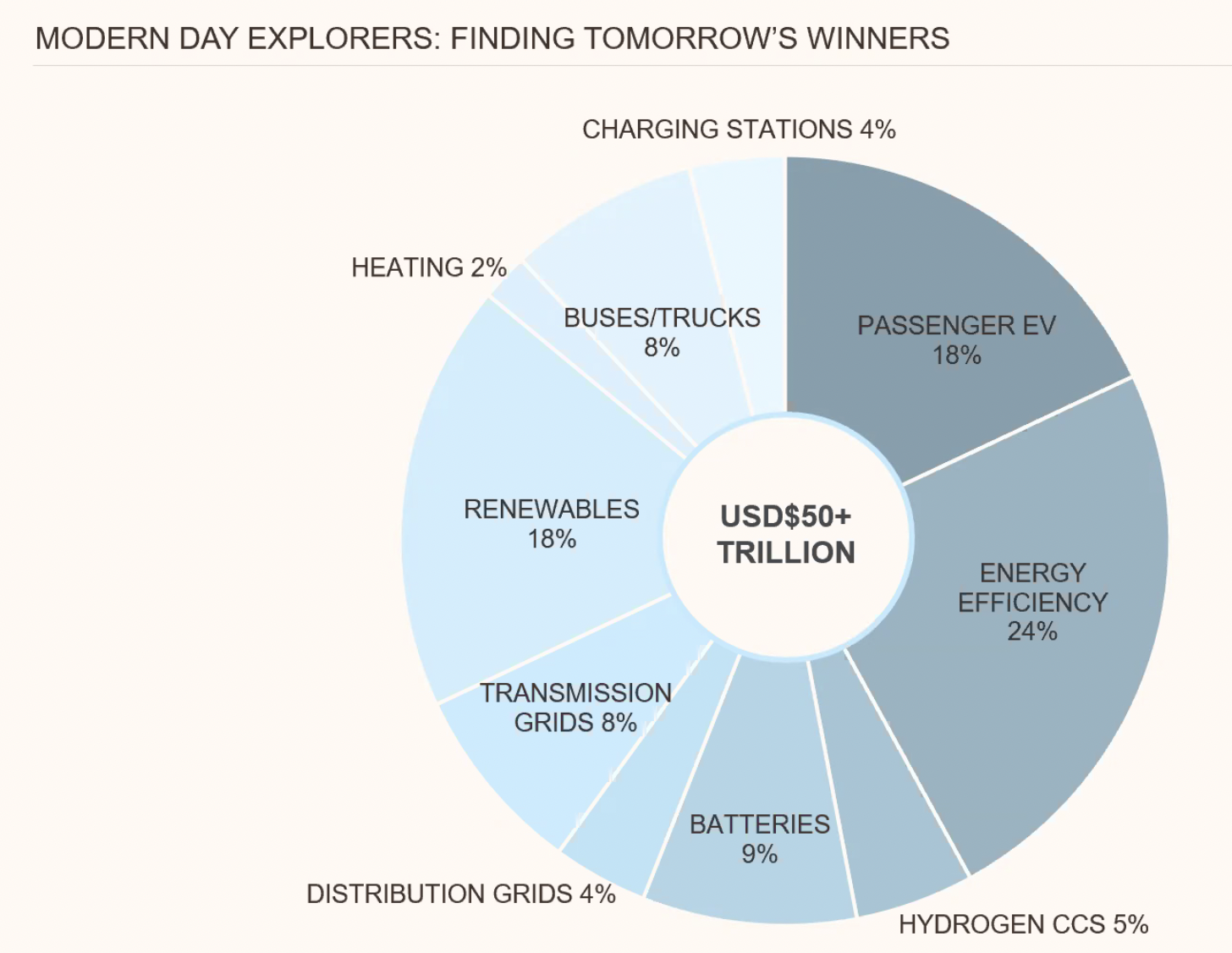
Munro's starting point for building out the Climate Fund's investible universe was this US$50 trillion figure; specifically where it is going to be spent over the next few decades.
A couple of years ago, the European Investment Bank provided estimates of where these trillions will be directed, which you can check out in the image above. At the time, the Bank predicted that 24% of funds would flow into companies trying to provide greener energy solutions, while 18% would funnel into passenger electric vehicles and 9% would be spent on batteries.
"This might actually move in Europe. For those that have been following, Europe's going to try to move from fossil fuels much quicker now that the situation with Russia has occurred," Tsinidis said.
"And so these (estimates) may well change and the numbers actually might get bigger."
Munro has split the Fund's investible universe into four categories: companies within clean energy, those within energy efficiency, clean transport plays, and companies with products/services that enable the circular economy, as seen below:
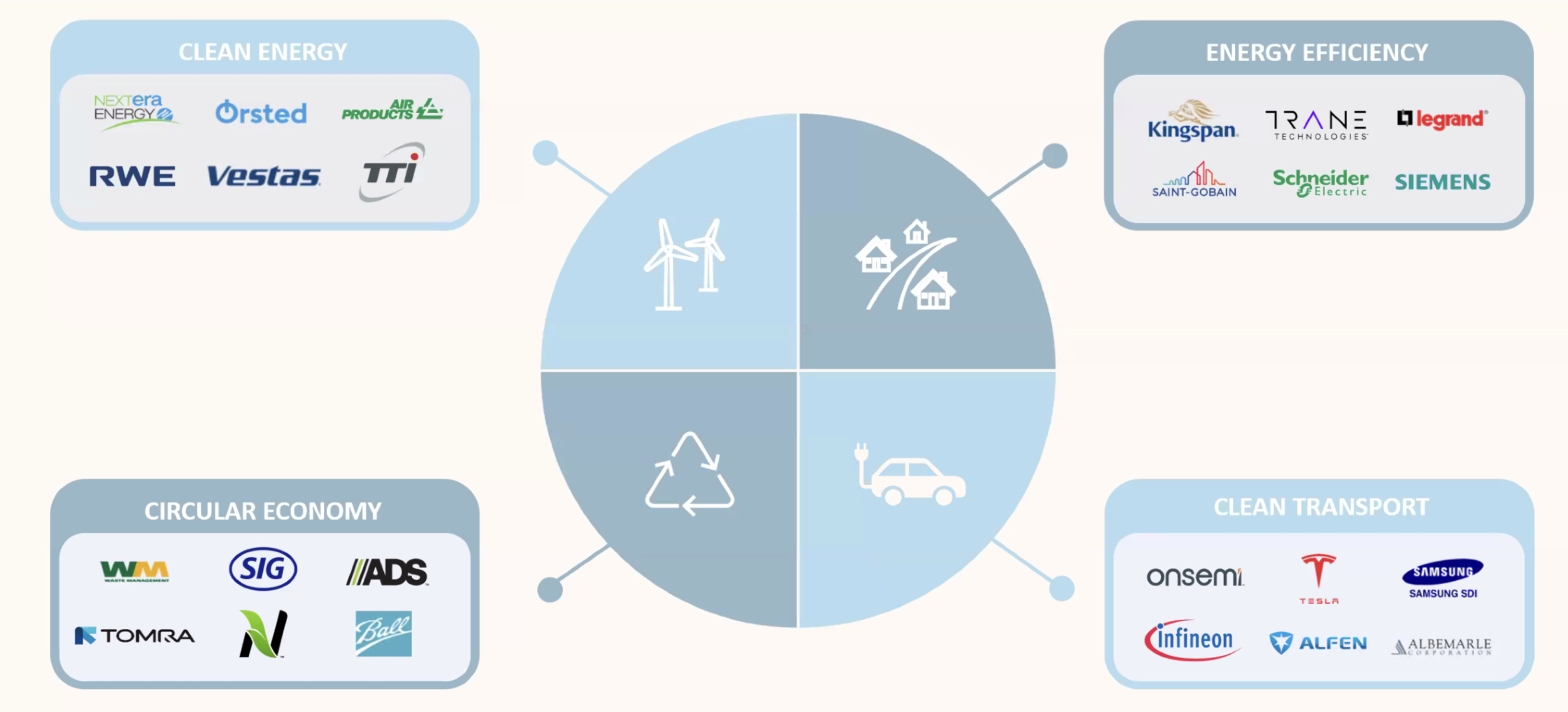
CLEAN ENERGY
One such company likely to benefit from the transition to a greener future, Tsinidis said, including NextEra Energy (NYSE: NEE), "the biggest utility in the US but also the largest developer of solar and wind in the world today."
"This company scores well for growth and economic leverage, i.e. its sales and EPS growth. So it's doing about a 10% growth per annum rate," he said.
"The sustainability of that growth of 10% is very strong. It scores five out of five there because this is a long term tailwind. We talked about 30 years to decarbonize the planet. It's not happening this year... It's going to be a sustained trajectory of that 10% growth rate."
The company doesn't score as well on the "control" score as other companies within Munro's investible universe as it's not founder-led, he said.
"Nonetheless (it has) strong incentives and so forth from management to basically invest for the future and that's what the management has a good track record of doing," Tsinidis said.
It also scores very well on "customer perception", as it's reliable and produces clean energy, he said.
"So all up, this leads us to pay a high teens EV/EBITDA multiple for the stock," Tsinidis said.
"It's not a cheap stock relative to the market, but still pretty decent relative to the company's sustainable growth rate of that 10% earnings CAGR, for a very long period of time."
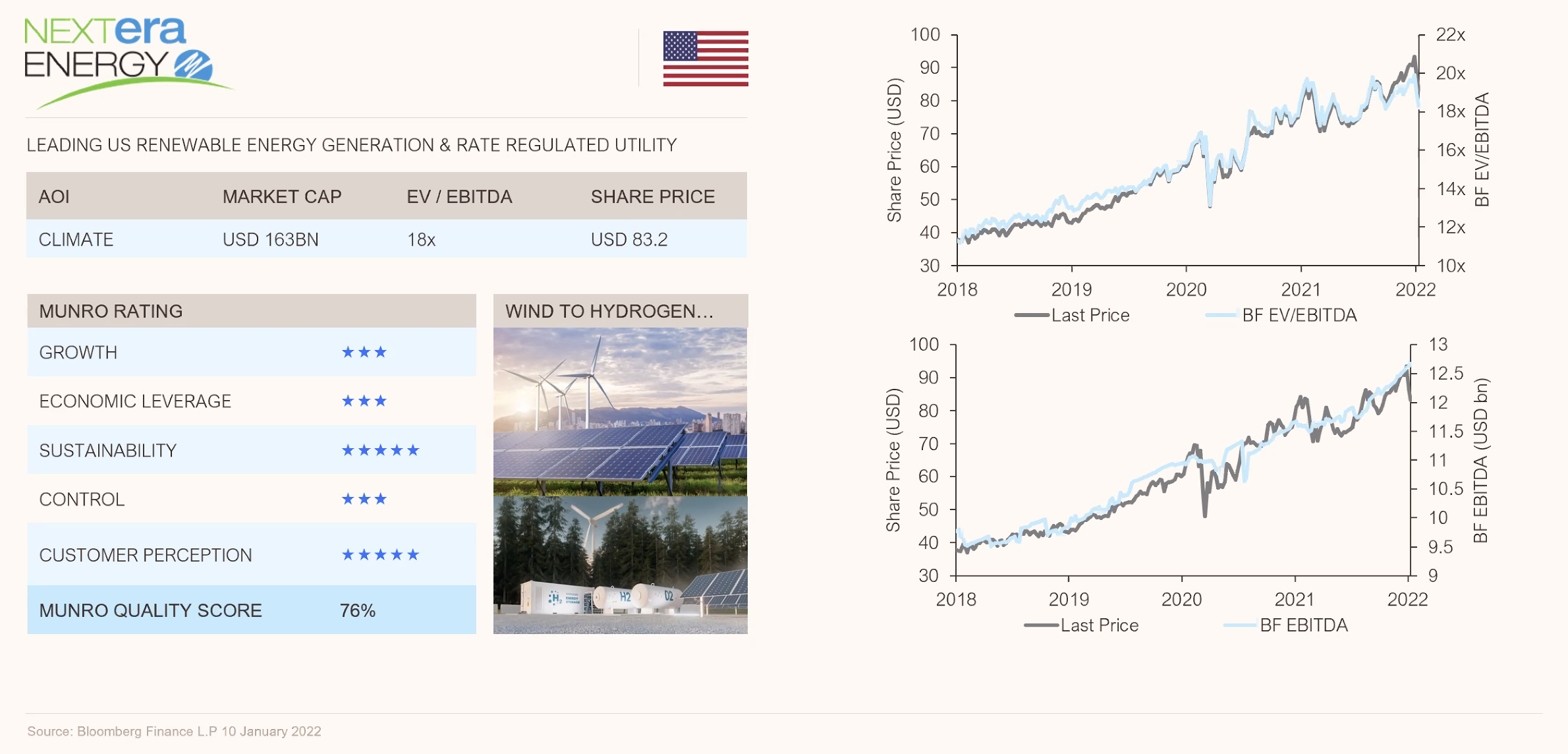
At the moment, electricity still lags behind fossil fuels as a source of global power consumption, he said.
"There's still a very large footprint in oil, gas, coal, etc. That electricity piece needs to take a lot more share. It needs to go to 50%, at least. And renewables need to take share within that," Tsinidis said.
"What's that going to lead to? It's going to lead to a build-out of renewables quite quickly... We expect actually 20x growth of renewables... that's going to be made up of a mix of onshore wind development, offshore wind development, but also solar as well."
The shift towards renewables actually makes "economic sense", Tsinidis explained, as the cost of solar and wind is actually below the cost of coal and gas.
"If you look at these today, with what's happening in fossil fuel markets and gas particularly, those prices have spiked, so it makes more sense now than ever to transition," he said.
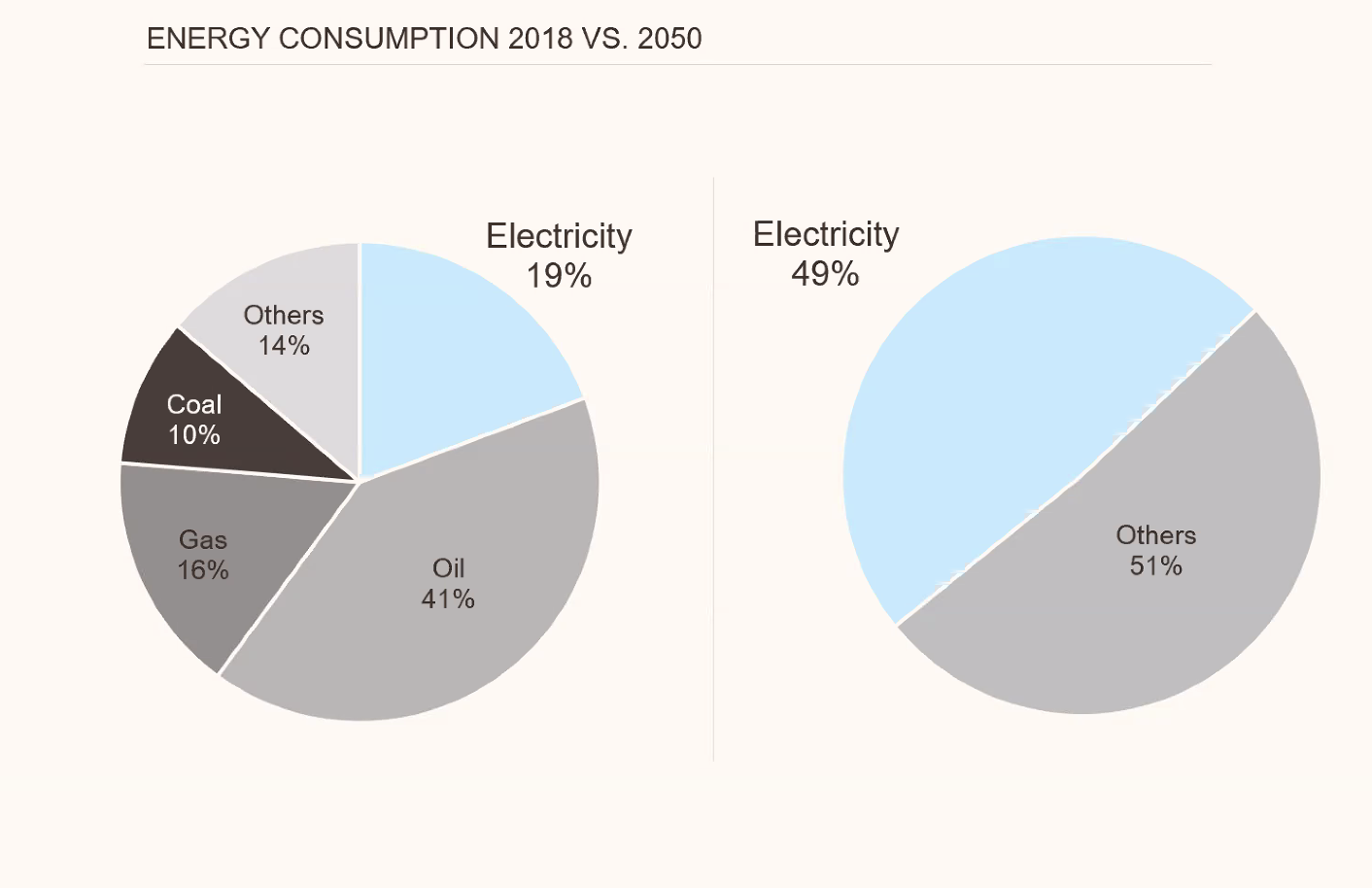
ENERGY EFFICIENCY
It's not just energy producers that will benefit, he said, with companies focused on energy efficiency - such as those involved in the retrofitting the buildings and homes, likely to lift on the tailwinds of decarbonisation.
"Insulation reduces the required heating amounts, we've followed companies like Kingspan (LON: KGP) for a very long period of time, it's an Irish insulation business company," Tsinidis said.
"Or Trane Technologies (NYSE: TT), which manufactures heating and cooling equipment, or companies like Schneider Electric (EPA: SU) which does smart electronics."
CLEAN TRANSPORT
Not surprisingly, clean transport has been getting the most attention at the moment from investors, with companies like Tesla and Rivian being bid up to dizzying heights, as well as companies involved in the supply chain of electric vehicles - semiconductors.
"People talk about the smartphone transition - mobile phones don't grow but smartphones went from 10% to 80%. And that ultimately created Apple which is the biggest company in the world today. Cars are going through the same transition," Griffin said.
"Today, (global car production) is roughly 90 million cars per annum - it's probably not going to grow much into the future. But electric cars are just starting their inflection point right now. And so electric cars are basically where smartphones were 15 years ago."
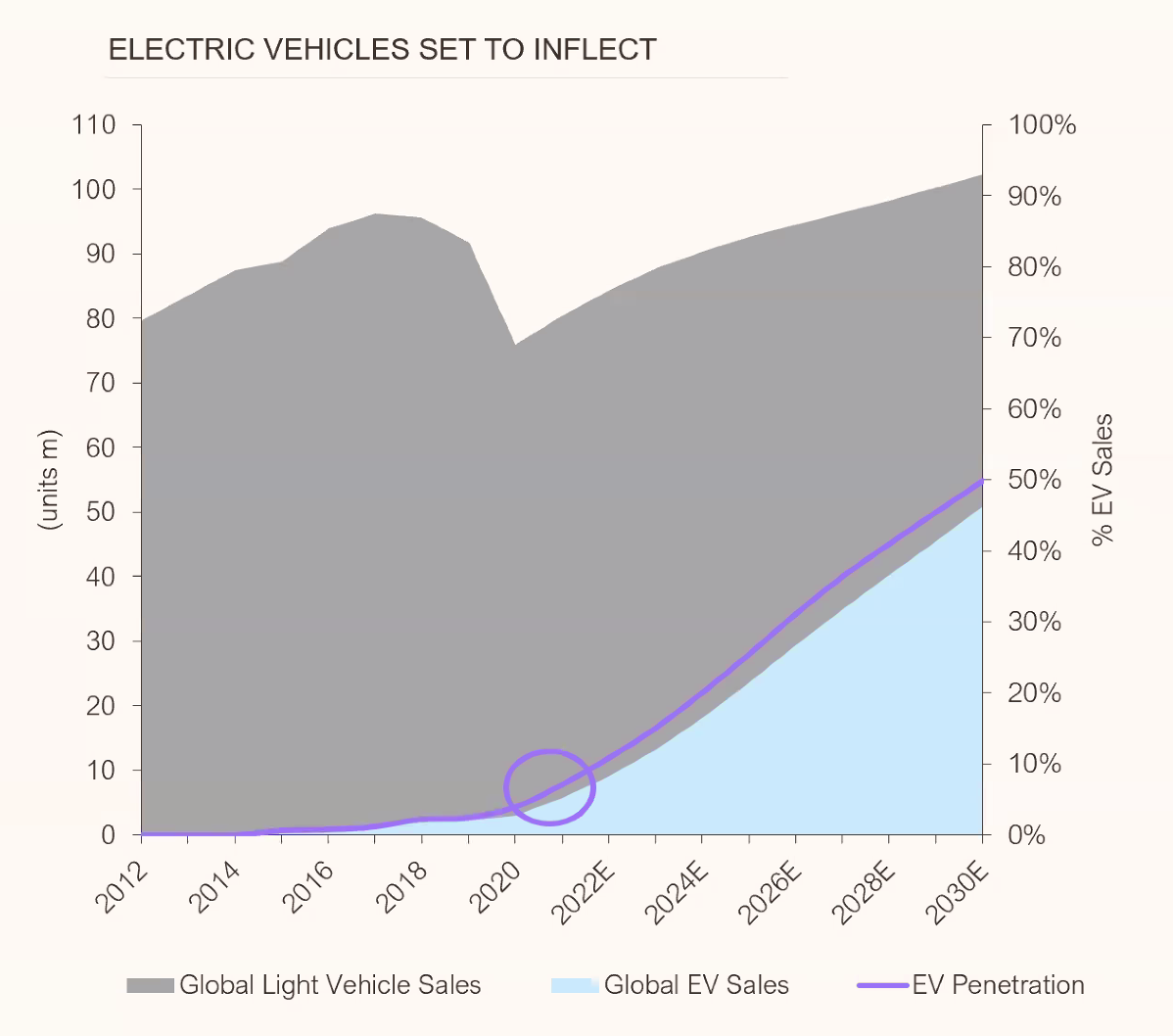
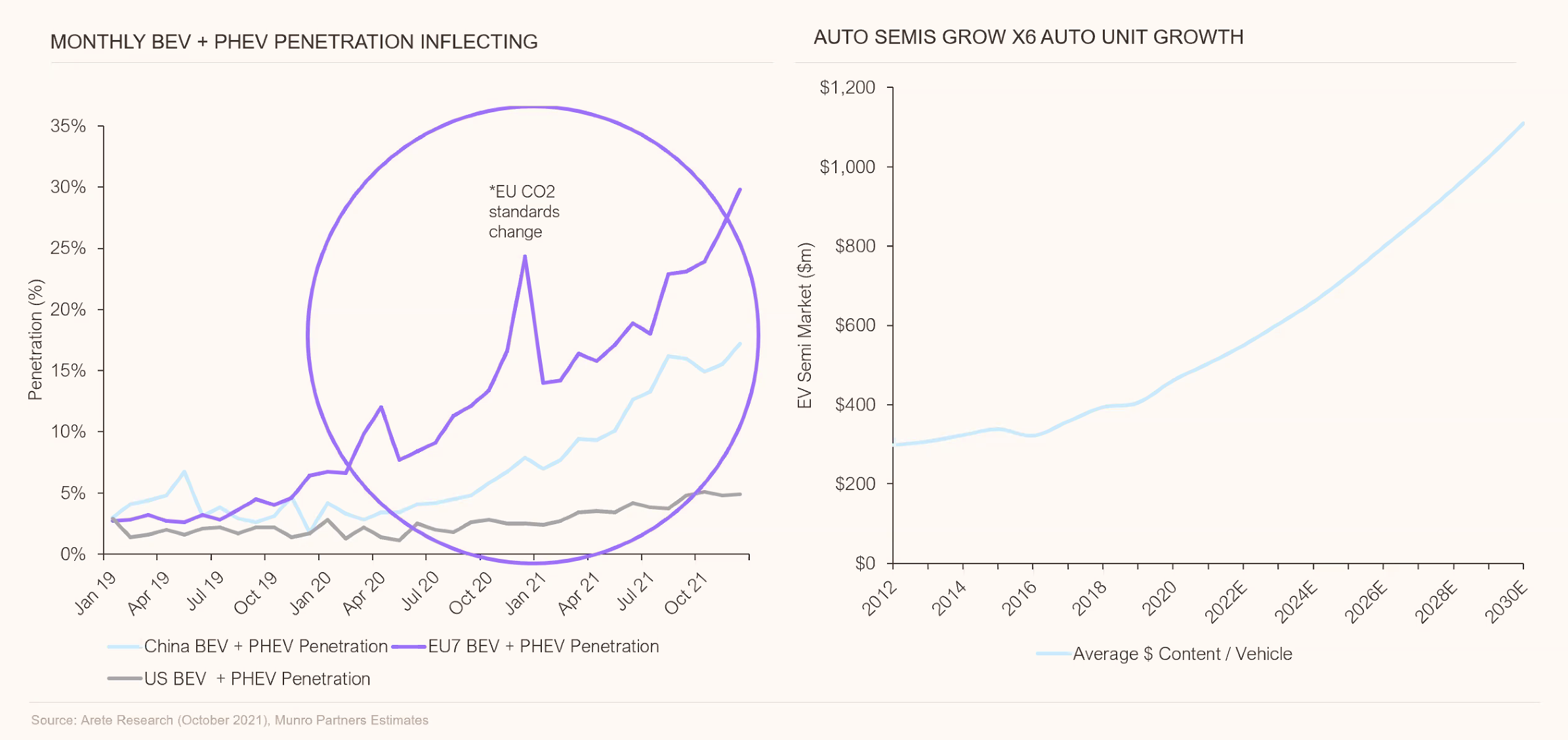
As the chart highlights above, 30% of every car that was sold in December 2021 in Europe was an electric car or plug-in hybrid electric vehicle. Similarly, over 15% of cars sold in China during the month were electric. In the US, and also for Australia, penetration still sits under around 5%.
"You can see there's a clear inflection occurring. And the inflection is occurring mainly because we're actually finally getting these vehicles coming to market," Griffin said.
"Previously, if you wanted to buy an electric car, you could only buy a Tesla. Now, other companies are getting to the market with cars and so if anything this would be going faster if more cars were available."
That said, the biggest (and easiest) opportunity for investors is in semiconductors, Griffin explained.
"Power semiconductors are the muscle in a muscle car," he said.
"Effectively you have to take a battery and turn it into torque rather than an internal combustion engine turning into torque and so you need a lot of semiconductors."
By 2030, Munro Partners expects that semiconductor content will reach over $1000 per car, from roughly $400 now.
"This happens regardless of whether you sell more cars or not. If you just sell 90 million cars per annum, this will happen. So this is a classic structural shift. It's a classic S curve opportunity," Griffin said.
Tsinidis and Griffin point to companies like onsemi (NASDAQ: ON), Infineon Technologies (ETR: IFX), Samsung SDI Co (KRX: 006400) and Albemarle Corporation (NYSE: ALB) as those likely to benefit.
"Power semis are going to have to go into every electric vehicle, every charging point, every renewable energy infrastructure - everything where you have to electrify the economy, you're going to need more power semis," Griffin said.
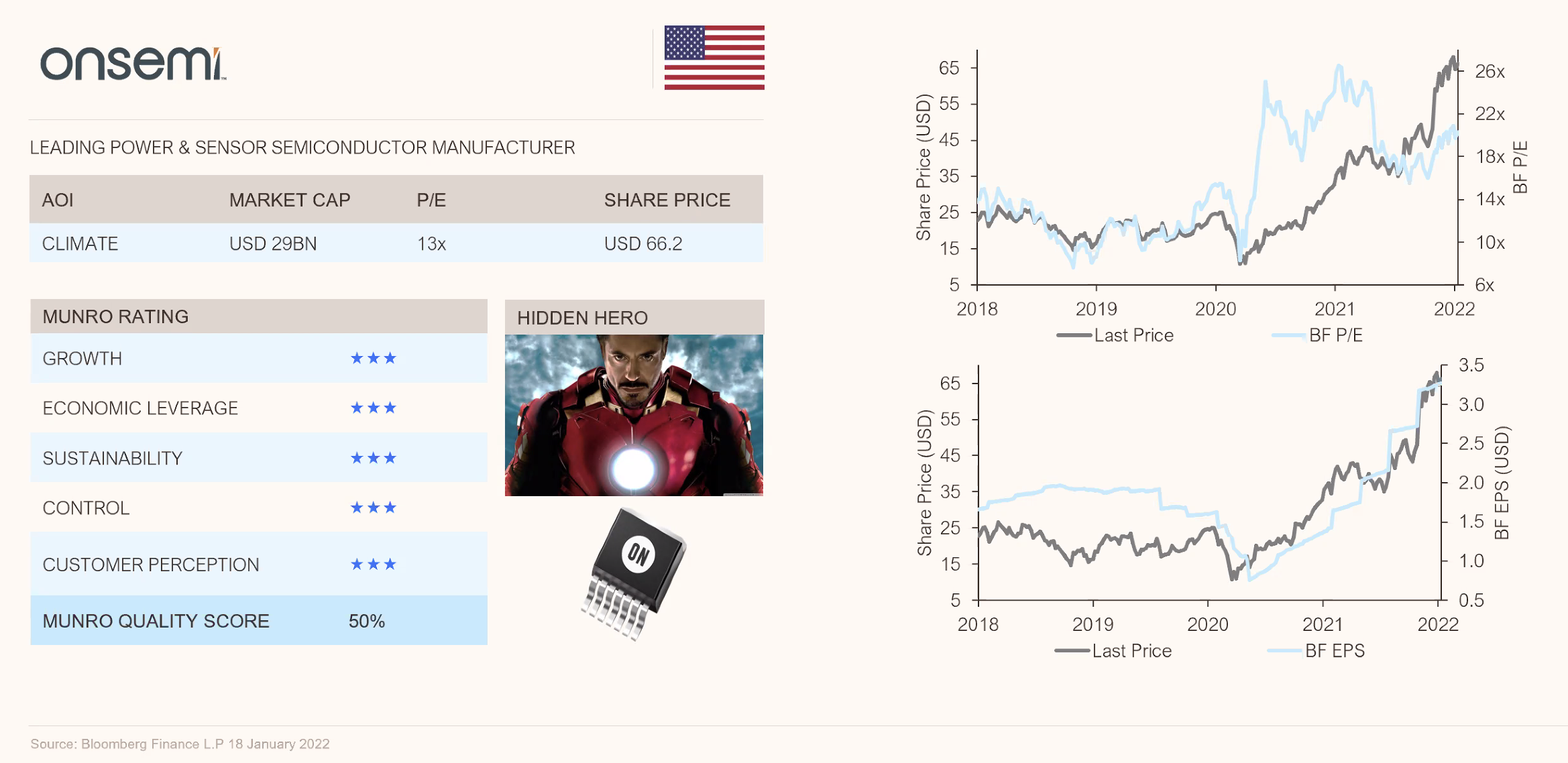
As such, the inflection in earnings that you can see in the onsemi chart above is likely to continue, Griffin said, regardless of what happens to the economy.
"Eventually the market will recognise the strength in this story and you can see it already has in the last year and we think that will continue into the future," he said.
"We'd say it's exactly the same for Infineon. And we'd say it's exactly the same for other parts in this electric car supply chain. Yes, there'll be bumps along the way. But the trend is clearly there."
THE CIRCULAR ECONOMY
The fourth area that Munro is exploring is the circular economy - those companies that recycle and reuse products, including businesses like Ball Corporation (NYSE: BLL), which is one of the world's biggest producers of recyclable metal beverage and food containers (and the Fund's second-largest holding).
This also includes Nutrien (TSE: NTR), a Canadian fertilizer company and currently the Fund's largest holding.
"So these are companies involved in basically reusing the natural resources that we have today because we do live in a scarce world and a world of scarcity," Tsinidis said.
"And so this is companies involved in collecting trash and recycling it, or collecting food waste and using it to produce biofuels. Companies involved in collecting plastic bottles and recycling plastic. Companies involved in a substrate shift as well - in basically reducing the world of plastic and maybe moving to aluminium cans in the case of Ball Corp."
Fund exposure in the current environment
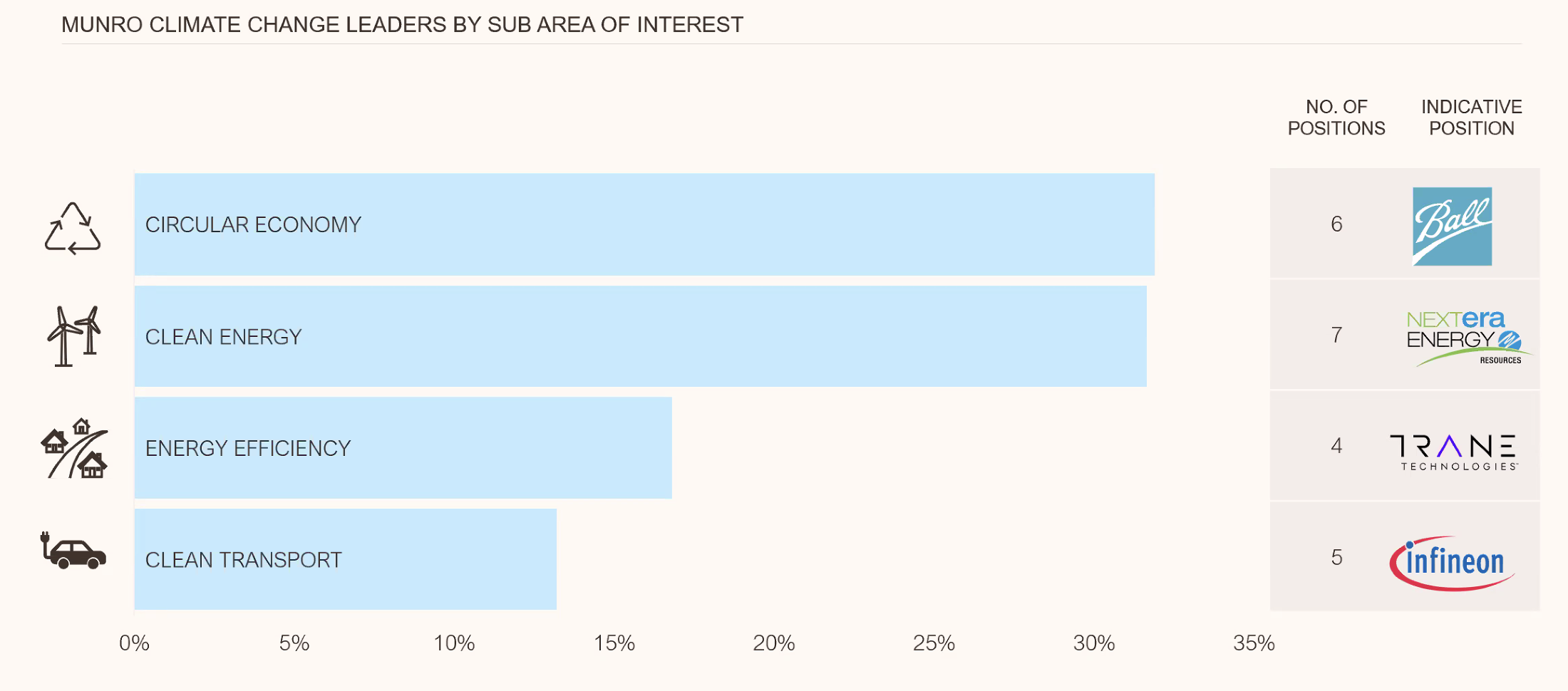
Currently, the Fund has a higher exposure to the circular economy and clean energy stocks, as these sub-segments are likely to be more defensive over the months ahead, Tsinidis said.
"Clean transport and energy efficiency is a smaller part of the Fund today than perhaps what we envisaged a couple of months ago and that's because these two segments are higher beta and have higher valuations," he said.
"Some of the clean transport stocks are quite expensive because they've been basically bid up by the market, not all of them, but some of them. So we have reduced that area coming out of last year and into this year as we expected the markets to become more difficult."
Meantime, energy efficiency names are more cyclical, as they are involved in renovation cycles, Tsinidis said.
"At the moment, we are a little more weighted to those more defensive areas, as we've sought to lift the average market cap of the Fund, lower the average valuation multiple of the Fund and also lower the beta of the Fund as well," he said.
"So that's why the portfolio is a little more tilted at the moment."
Europe is leading the charge on climate action
Unlike Munro's other funds, its Climate Fund has greater exposure to European companies.
"It's no surprise to people that Europe's leading the charge here on the climate side. And so that's why we have a little bit more exposure there to Europe and then the other funds," Tsinidis said.
Similarly, the investment manager's other funds have more exposure to tech, while the Climate Fund only has 5% of its portfolio allocated towards this sector.
"Because we're investing in a portfolio of companies that enable the decarbonisation of the planet, you end up in more companies that are actually building things and making things," he said.
"So that leads you to more industrial types of companies; utilities and materials, and less so tech."
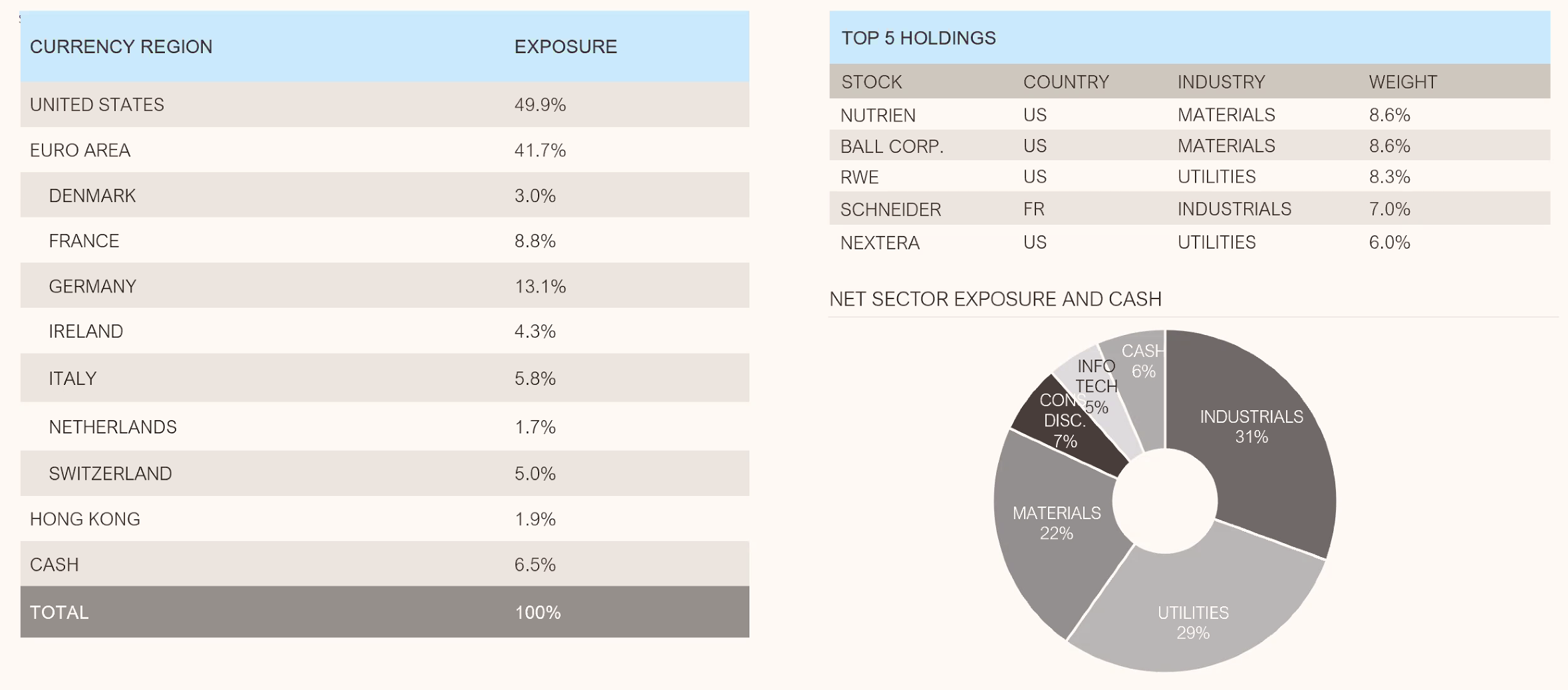
Never miss an update
Enjoy this wire? Hit the 'like' button to let us know. Stay up to date with my content by hitting the 'follow' button below and you'll be notified every time I post a wire.
Not already a Livewire member? Sign up today to get free access to investment ideas and strategies from Australia’s leading investors.
4 topics
2 contributors mentioned

